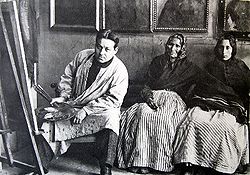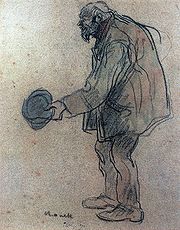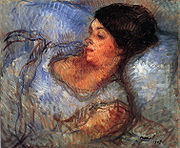
Isidre Nonell
Encyclopedia

Barcelona
Barcelona is the second largest city in Spain after Madrid, and the capital of Catalonia, with a population of 1,621,537 within its administrative limits on a land area of...
, Spain
Spain
Spain , officially the Kingdom of Spain languages]] under the European Charter for Regional or Minority Languages. In each of these, Spain's official name is as follows:;;;;;;), is a country and member state of the European Union located in southwestern Europe on the Iberian Peninsula...
- February 21, 1911, Barcelona) a Catalonia
Catalonia
Catalonia is an autonomous community in northeastern Spain, with the official status of a "nationality" of Spain. Catalonia comprises four provinces: Barcelona, Girona, Lleida, and Tarragona. Its capital and largest city is Barcelona. Catalonia covers an area of 32,114 km² and has an...
n painter and drawer belonging to post-impressionism
Post-Impressionism
Post-Impressionism is the term coined by the British artist and art critic Roger Fry in 1910 to describe the development of French art since Manet. Fry used the term when he organized the 1910 exhibition Manet and Post-Impressionism...
known for his expressive portrayal of the socially marginalized of Barcelona society. (He is also said to belong to modernism
Modernism
Modernism, in its broadest definition, is modern thought, character, or practice. More specifically, the term describes the modernist movement, its set of cultural tendencies and array of associated cultural movements, originally arising from wide-scale and far-reaching changes to Western society...
and postmodernism
Postmodernism
Postmodernism is a philosophical movement evolved in reaction to modernism, the tendency in contemporary culture to accept only objective truth and to be inherently suspicious towards a global cultural narrative or meta-narrative. Postmodernist thought is an intentional departure from the...
.)
Life




Sant Pere, Barcelona
Sant Pere is a neighborhood in District 1 , the old city of Barcelona, Spain. It is named after the monastery Sant Pere de les Puelles...
in the old part of town in Barcelona
Barcelona
Barcelona is the second largest city in Spain after Madrid, and the capital of Catalonia, with a population of 1,621,537 within its administrative limits on a land area of...
, he developed artistic ambitions at an early age.
His early teachers included Josep Mirabent, Gabriel Martínez Altés and Lluís Graner. From 1893 to 1895 he studied at the Escola de Belles Arts de Barcelona (Fine Arts School of Barcelona). He met Ricard Canals, Ramón Pichot
Ramon Pichot
Ramon Pichot Gironès was a Catalan and Spanish artist. He painted in an impressionist style.He was a good friend of Pablo Picasso and an early mentor to young Salvador Dalí. Salvador Dalí met Ramon Pichot Gironès in Cadaqués, Spain when Salvador was only 10 years old. Ramon also made many trips...
, Juli Vallmitjana, Adrià Gual
Adriá Gual
Adrià Gual i Queralt was a Catalan playwright and theatre businessman, founder of the Escola Catalana d'Art Dramàtic and a pioneer of cinema in Barcelona.-Theater:*Misteri de dolor*Donzell qui cerca muller*L'emigrant...
, and Joaquin Sunyer with whom he developed an interest in landscape painting, studying light. The study of sunlight and its effects on color were a main part of Impressionism
Impressionism
Impressionism was a 19th-century art movement that originated with a group of Paris-based artists whose independent exhibitions brought them to prominence during the 1870s and 1880s...
, which was then active. They were called the "Saffron Group" for the warm tones they used, as well as the "Sant Martí Group" after the town they painted in.
In 1894, he began producing illustrations for La Vanguardia
La Vanguardia
La Vanguardia is Catalonia's leading daily newspaper as well as the fourth best-selling in Spain. It has its headquarters in Barcelona, Catalonia's largest city....
. He later drew for other periodicals, including L’Esquella de la Torratxa, Barcelona Cómica, Pèl & Ploma, and Forma.
In 1896, Nonell went with Ricard Canals and Juli Vallmitjana to the spa town of Caldes de Boí in the Catalonian Pyrenees
Pyrenees
The Pyrenees is a range of mountains in southwest Europe that forms a natural border between France and Spain...
to work at the spa run by Vallmitjana's family. There, he saw a large number of people suffering from the illness of cretinism
Cretinism
Cretinism is a condition of severely stunted physical and mental growth due to untreated congenital deficiency of thyroid hormones usually due to maternal hypothyroidism.-Etymology and use of cretin:...
, which became a subject of his paintings.
In February 1897, he went to Paris with Ricard Canals. There he exhibited and shared a studio with Picasso. He returned to Barcelona in 1900. At the beginning of 1901, he made paintings of women, such as gypsy and working-class women, and still lifes. He exhibited in the Sala París in Barcelona twice, in 1902 and 1903. The reaction to his works of poor gypsy women was very hostile.
His Work
The oil paintings show the influence of impressionismImpressionism
Impressionism was a 19th-century art movement that originated with a group of Paris-based artists whose independent exhibitions brought them to prominence during the 1870s and 1880s...
and pointillism
Pointillism
Pointillism is a technique of painting in which small, distinct dots of pure color are applied in patterns to form an image. Georges Seurat developed the technique in 1886, branching from Impressionism. The term Pointillism was first coined by art critics in the late 1880s to ridicule the works...
expressed in a new way. Thick strokes layered one after another do not quite mix colors in the eye, leaving a directness of emotion. His subjects, most often women, are the poor and marginalized people of society: poor women (often with children), gypsies, wounded soldiers repatriated from the Cuban war
Spanish-American War
The Spanish–American War was a conflict in 1898 between Spain and the United States, effectively the result of American intervention in the ongoing Cuban War of Independence...
, and people suffering from cretinism
Cretinism
Cretinism is a condition of severely stunted physical and mental growth due to untreated congenital deficiency of thyroid hormones usually due to maternal hypothyroidism.-Etymology and use of cretin:...
.
Though, his magazine drawings were critical of society, his other works show a deep feeling for those who suffered. His frank portrayal of poverty earned him mostly criticism and rejection.
External links
- www.isidrenonell.cat Catalogue raisonnéCatalogue raisonnéThe typical catalogue raisonné is a monograph giving a comprehensive catalogue of artworks by an artist.The essential elements of a catalogue raisonné are that it purports to be an exhaustive list of works for a defined subject matter describing the works in a way so that they may be reliably...
- Ciudad de las Pinturas, an extensive collection of online images
- All Biographies entry for Nonell

